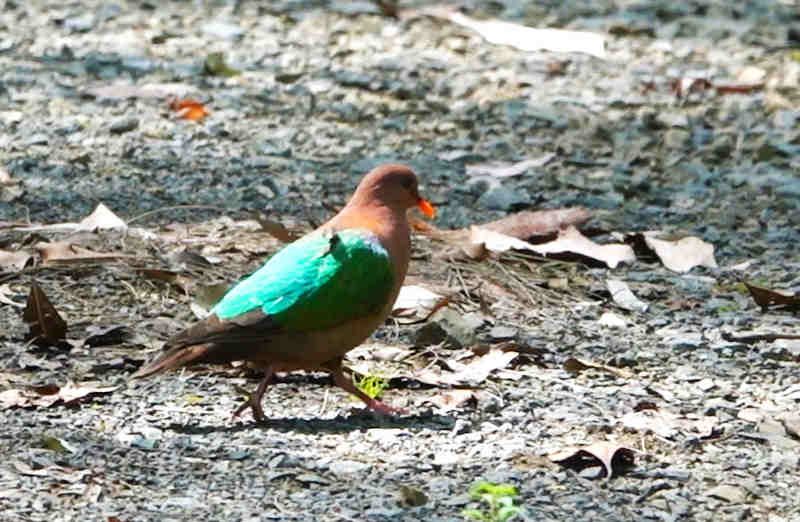Pacific Emerald Dove (Chalcophaps longirostris)

The Pacific Emerald Dove (Chalcophaps longirostris), also known as the green-winged dove, is a stunning member of the pigeon family, renowned for its shimmering plumage and graceful demeanour. Found primarily in the tropical forests and coastal regions of Southeast Asia and Oceania, this bird captivates birdwatchers and nature enthusiasts with its iridescent beauty and gentle habits.
Physical Description
The Pacific Emerald Dove is aptly named for its dazzling, emerald-green feathers that adorn its wings and upper body. The contrasting maroon-brown head and body, combined with a white shoulder patch, create a striking palette. The eyes are dark and soulful, and the bill is slender and reddish. Males and females are similar in coloration, though the male’s crown tends to be more vivid in hue.
The average size of this dove ranges from 23 to 27 centimetres (9 to 10.5 inches) in length. Its soft cooing call is often heard before the bird is seen, a gentle sound that resonates through the dense foliage.
Habitat and Distribution
The Pacific Emerald Dove is commonly found in rainforests, mangroves, and dense woodlands. Its range extends across the eastern parts of Indonesia, Papua New Guinea, and the tropical regions of northern Australia. It thrives in both primary and secondary forests, often spotted along forest edges, paths, and clearings where food sources are abundant.
Behaviour and Diet
This dove is primarily a ground feeder, foraging for fallen fruit, berries, seeds, and insects. Its strong, purposeful walk allows it to cover significant ground while foraging. Despite its bright coloration, the bird’s plumage offers excellent camouflage among the forest floor’s foliage and shadows.
Pacific Emerald Doves are usually solitary or seen in pairs. During the breeding season, males perform an elegant courtship display, bowing and cooing to attract a mate. Once paired, the dove constructs a simple nest of twigs in the low branches of a tree. The female typically lays one or two small, white eggs. Both parents share incubation duties and care for the young after they hatch.
Conservation Status
The International Union for Conservation of Nature (IUCN) currently lists the Pacific Emerald Dove as a species of Least Concern. While its populations are generally stable, habitat loss due to deforestation poses a potential threat. The conservation of tropical forests is essential to ensure the survival of this exquisite bird and many other species that share its habitat.
Significance to Birdwatchers
For birdwatchers, spotting a Pacific Emerald Dove is a memorable highlight. Its quiet demeanour and breathtaking coloration make it a prized species for photography and observation. The dove’s preference for foraging along trails provides frequent, though fleeting, opportunities to witness its beauty in the wild.
Cultural Importance
In various indigenous cultures of the Pacific and Southeast Asia, doves are often seen as symbols of peace, love, and harmony. The Pacific Emerald Dove , with its serene nature and enchanting appearance, embodies these qualities, making it a beloved presence in the forests where it dwells.
Protecting a Forest Gem
The Pacific Emerald Dove ’s survival depends on the preservation of its forest habitats. Supporting initiatives that combat deforestation, promote sustainable land use, and foster eco-tourism can help ensure that future generations continue to experience the magic of encountering this radiant bird. By protecting the ecosystems it calls home, we contribute not only to the dove’s future but to the health of our planet as a whole.
In every glimpse of its shimmering wings, the Pacific Emerald Dove reminds us of nature’s capacity to dazzle and inspire. Whether observed in the wild or admired through photographs, this jewel of the forest serves as a symbol of biodiversity’s delicate beauty and resilience.
We are affiliated with Amazon and make a small royalty at no extra cost to you, so by using the links below to purchase your next birding gear you can help us to maintain Simply Birding and continue to bring great content:

Canon, Sony and Nikon cameras: https://amzn.to/4gmtDWk

Lenses for bird photography: https://amzn.to/3WG3vyF

Tripods: https://amzn.to/3PVDNT0

Memory Cards: https://amzn.to/3PV4Y0z

Bird books: https://amzn.to/42NgsKS

Binoculars for bird watching: https://amzn.to/42G0nGZ

Spotting Scopes for bird watching: https://amzn.to/4hom5nq















